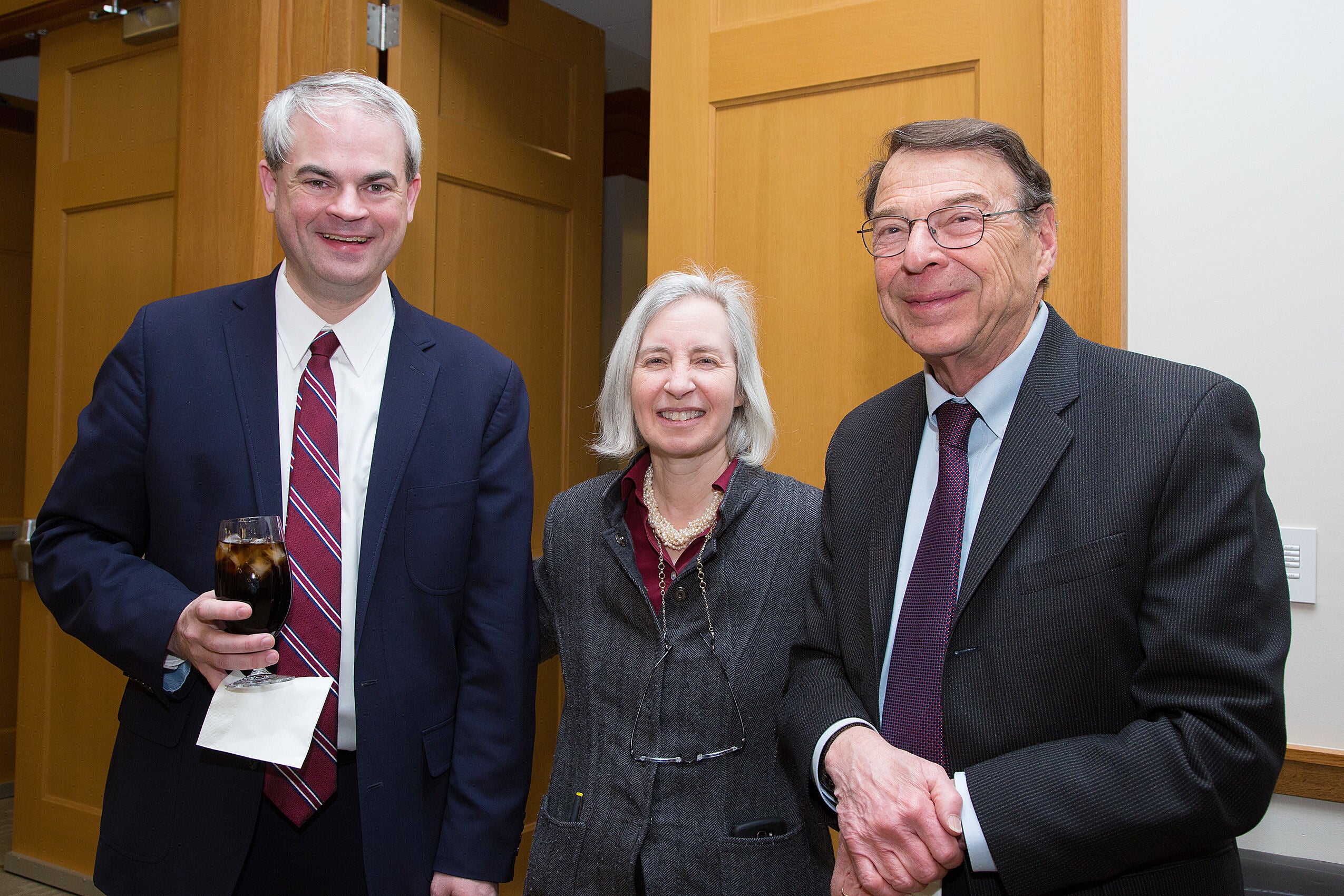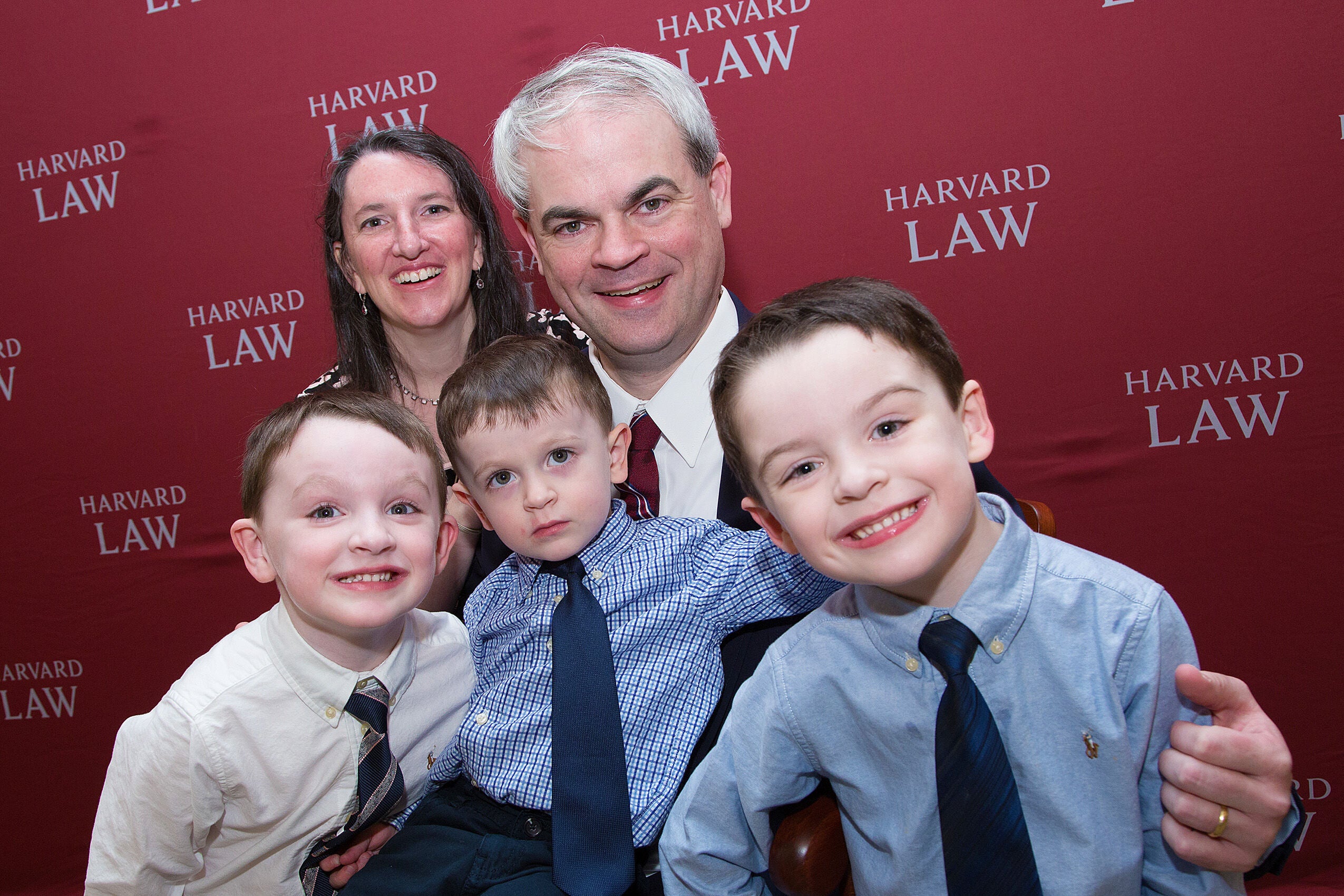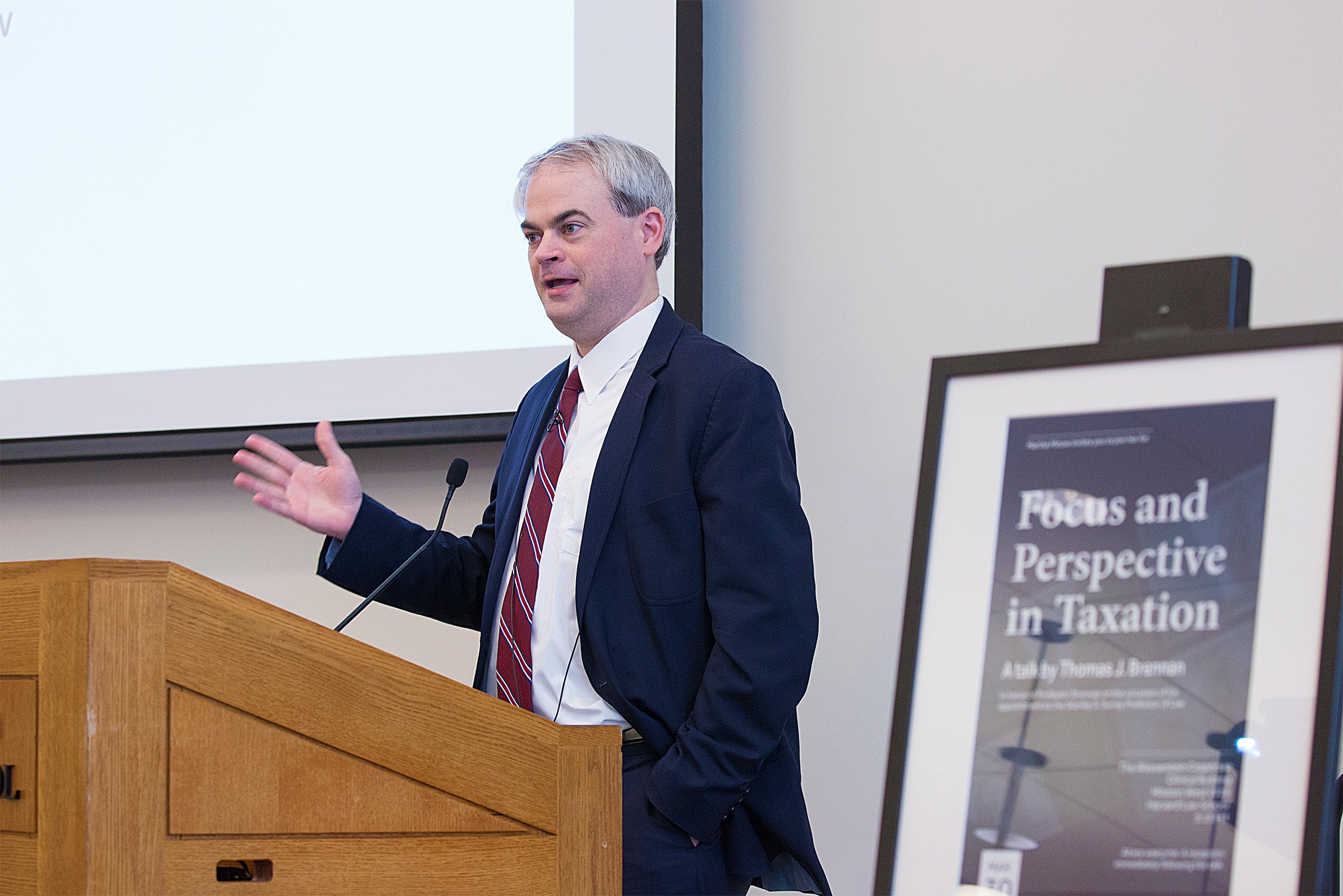In a lecture marking his appointment as the Stanley S. Surrey Professor of Law at Harvard Law School, Tom Brennan ’01 delivered a talk titled “Focus and Perspective in Taxation.”
Introducing Brennan, Harvard Law School Dean Martha Minow praised his accomplishments and experience, and said: “He’s a trifecta, theory, practice — practice on the law side, practice on the finance side.”
Brennan, who joined the HLS faculty in 2015, has served as a strategist in the capital markets strategy group at Goldman Sachs, as an associate in the tax department at Cravath, Swaine & Moore, and as a professor at several universities. His research focuses on applying finance and economics to analyze and inform tax policy, using empirical methods to investigate the effects of tax laws and the strategic behavior of taxpayers.
Brennan’s March 30 chair lecture focused on the issue of defining economic ownership and also the issue of uncertainty in future tax rates.

Credit: Martha Stewart Among Thomas Brennan’s many family, friends and colleagues in attendance were (from left) Professor Emeritus Daniel Halperin; Lecturer on Law Stephen E. Shay; and Michael L. Schler of Cravath Swaine & Moore. Brennan assumes the chair from Professor Halperin, who was named Stanley S. Surrey Professor of Law in 1996.
According to Brennan, because tax consequences depend on who owns property, in complex ownership cases–for example, in which there are multiple owners or contingent share schemes–it becomes very complicated to figure out how income derived from the property or gain on sale of a property should be taxed. “Financial innovation has made the problem even more acute by constructing derivatives that are created in an effort to exploit the difficulties the tax system has with identifying the correct owner,” he said. “You can sort of make a mockery of the attempt to impose rules and just sort of dance around them.”
Brennan’s presentation included a graph of a payoff diagram, with stock prices (the payoff of holding stock) on the horizontal axis and the payoff from a contingent claim on the stock on the vertical axis, to illustrate how sellers neutralize risk and avoid taxation. While the government has developed rules over time to address the problem, Brennan said, the response is incomplete and inadequate in various ways.
“One might imagine that the rules that Congress has crafted to deal with constructive sales of the sort that I’m talking about, or regulations promulgated thereunder, might make reference to where you think the stock is going to be and how much variation there is in it,” Brennan said. “One might imagine that, but there are no such laws and there are no such rules. They rather simply focus on how the diagram looks and sort of meditate on it for a bit and forget that there’s an underlying stock value that you might care about the distribution of.”
Brennan also discussed future tax uncertainty — when taxpayers have a choice between paying a tax now or paying a tax later, as is the case in Roth retirement accounts versus traditional retirement accounts, or repatriation versus deferral of overseas corporate earnings. “One way I can think about this,” said Brennan, “is that we’re causing people to build up to cliffs. We’re building a big mountain, lots of money getting put overseas, waiting for a tax holiday for repatriation, lots of money getting put in retirement accounts, thinking that there’s going to be some particular tax rate. It would be better if we didn’t make people concentrate risk in big piles like we do.”
Future tax uncertainty is an important question, according to Brennan, because of the enormous amounts of money that are at stake. “Unrepatriated earnings are currently estimated to be at least $2.6 trillion, at least in 2016,” said Brennan, citing the Joint Committee on Taxation’s estimate. “The retirement account amounts in traditional and Roth IRAs are $6.2 trillion and $0.7 trillion, respectively.”

Credit: Martha Stewart Brennan with Dean Minow and Professor Halperin at a reception following the talk.
After working in the private sector at Goldman Sachs and Cravath, Swaine & Moore, Brennan entered academia. His appointments include serving as a professor at Northwestern University School of Law, and as a professor of finance, by courtesy, at Northwestern University’s Kellogg School of Management. He was also an assistant professor of law at the Drexel University School of Law, a visiting scholar affiliated with the Laboratory for Financial Engineering at the MIT Sloan School of Management and a lecturer in the finance and economics department of the Boston University School of Management.
In 2014, he co-authored the chapter “Portfolio Theory” for the Princeton Companion to Applied Mathematics, and he has contributed to numerous scholarly journals, including the Yale Journal on Regulation, the Annual Review of Financial Economics, the Texas Law Review, the Quarterly Journal of Finance, and Management Science.
Brennan received his undergraduate degree summa cum laude in Mathematics from Princeton University and holds a Ph.D. in Mathematics from Harvard University.

Credit: Martha Stewart Several of Brennan’s family members were also in attendance, including his wife, Cathryn, and their three children, Johnny, Tommy and Danny.
Brennan’s endowed chair is named in honor of the late HLS Professor Stanley Surrey, a highly respected tax teacher and scholar who made extraordinary contributions to the improvement and modernization of tax systems in the United States, and in countries in Latin America, the Middle East, and Asia.
In his remarks, Brennan said it was an incredible honor to receive the chair in Surrey’s name. He also said it was an incredible honor to follow the first Stanley S. Surrey Professor of Law at Harvard Law School, Daniel Halperin, who was in attendance, along with many of Brennan’s other colleagues.
A professor at HLS from 1950 to 1981, Surrey combined theory and practicality, and was a dominant figure in world and tax policy in the mid-20 century. Prior to his career in academics, Surrey worked for the National Recovery Administration, the National Labor Relations Board, and then for a decade as tax legal counsel for the United States Treasury. A member of the American Tax Mission to Japan from 1949 to 1950, he helped develop a new tax system for that country.
Surrey was also involved in American tax reform. Starting in 1948, he was the Chief Reporter of the American Law Institute’s Federal Income Tax Project, which was the institute’s first venture into tax. He guided its many reforms of the IRS Code of 1954. And as supervisor of the project from 1975 to 1984, he directed the publication of the World Tax Series and the training of more than 700 tax officials and teachers from around the globe.
During the Kennedy and Johnson administrations, he served as Assistant Secretary of the Treasury, where he worked toward enacting two major tax reform bills, the Revenue Acts of 1962 and 1964. He also helped law the groundwork for the Tax Reform Act of 1969.
